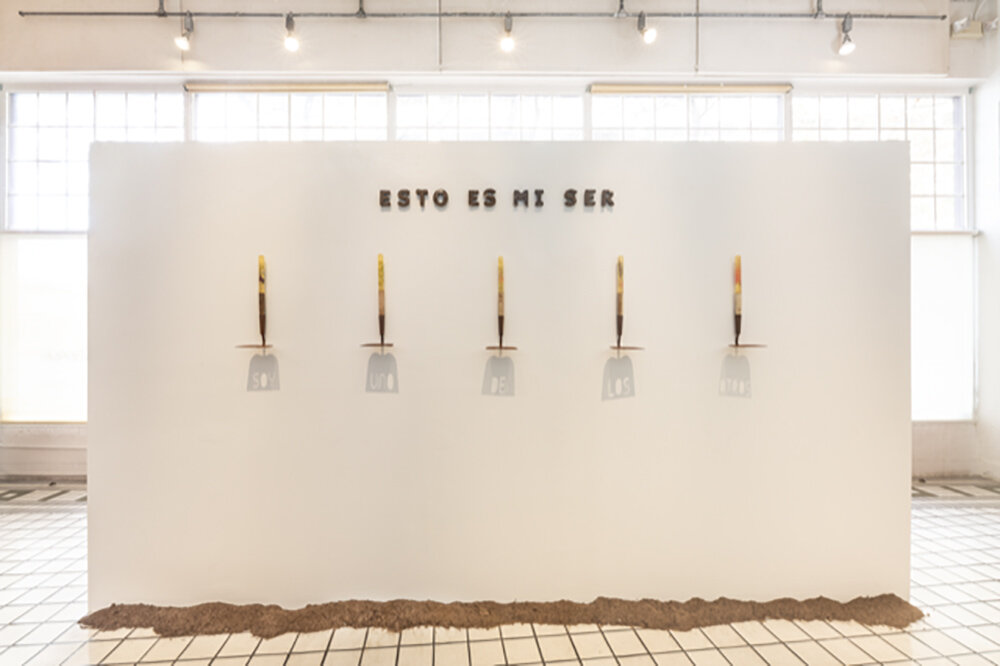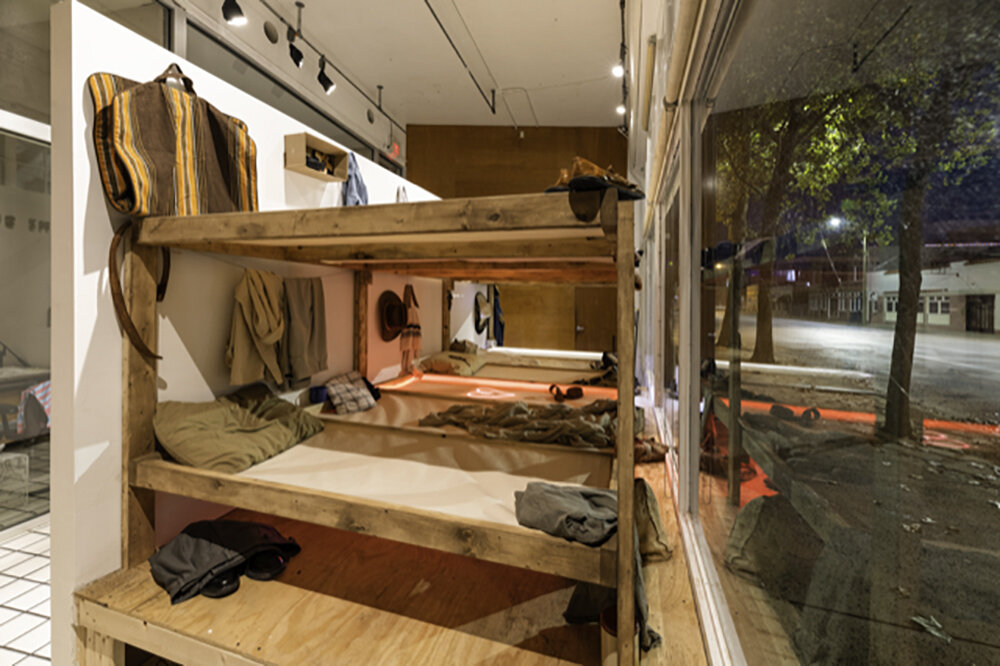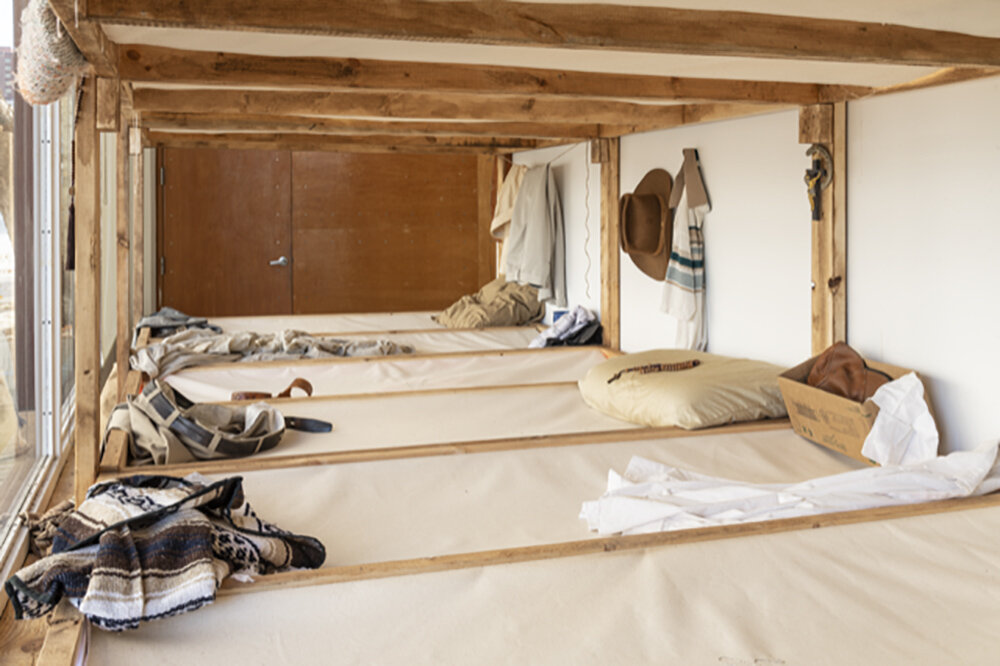Chinga tu Machismo: José Villalobos Transcends Cultural Boundaries Through Art
February 26, 2021 - San Antonio
José Villalobos’s latest exhibit, “de los otros”, explores the story of a gay bracero man in a culture that heavily erases queer voices. The exhibition is Artpace’s first main exhibit piece and will be featured until April 25. Courtesy Images: Artpace San Antonio, Photos by Beth Devillier.
By: Valeria Torrealba - Senior Reporter, San Antonio Sentinel
Born and raised between the border of El Paso, Texas and Juárez, Mexico, artist José Villalobos defies cultural boundaries, challenging machismo in Latinx culture and bringing to life his emotions and upbringing as a Mexican-American man — his latest Artpace exhibit, de los otros, unveils the life of a gay bracero worker, alluding to Villalobos’s personal upbringing at the border.
Villalobos explored his identity as both Mexican and American throughout his childhood, reminiscing often with family as he visited them often.
“Between El Paso and Ciudad Juárez, a lot of my upbringing was going to Juárez quite often because a lot of my family was there. And so I grew up in the border,” Villalobos said. “You know it's [like a] kid, trying to also to like understand your environment, right, so.. Understand what it’s like to be American, but also to be Mexican — there’s this really specific dynamic that exists with being in the border.”
Villalobos’s upbringing was unlike many. With the passing of his father as a child, José found himself working full time at just 16 years old in order to support his mother. Surrounded by all the men in his family, the culture of machismo was deeply engraved in him, marking a barrier he would soon break with his own two hands.
“I lost my father when I was 10, so having these male figures — all these different types of men trying to raise me a certain way and what it was to be a man in El Paso — was part of my upbringing,” Villalobos says. “I eventually moved to San Antonio because I felt that I needed to be away from specific things, and I wanted to get out of this specific small town. I really just came to San Antonio with $80 to my name. I went to an interview, got a job, and it was just a gamble.”
Aspiring to be a writer, Villalobos shifted gears and put himself through school, eventually graduating from the University of Texas at San Antonio with a Bachelor of Fine Arts degree.
“Originally, I wanted to be a writer. I ended up taking an art class. I’ve always been creative as a kid, whether it was using popsicle sticks, or Legos. I was always interested in the arts,” Villalobos said. “I didn’t know too much about what art really was — I was never really introduced as a kid [because of my upbringing]. I went into writing, but once I took my first art class, I fell in love with this creative side that I had.”
As his career began to flourish, Villalobos took it upon himself to network as much as possible and get his art into exhibits — his first one debuting at the Guadalupe Cultural Arts Center, in which he explored the importance and legacy of a male’s last name in Latinx culture. These struggles are what propelled him forward, allowing him to center into the specific themes that he endured throughout his upbringing as a closeted gay man.
“Being an artist is — excuse my language — a bitch and a half, it’s tough, and, it’s, like, how do you get these opportunities, and how do you become an artist?” Villalobos said. “For me, it was very important to talk about a specific topic that is very deep and personal to myself, because I grew up closeted and I never was out until late. I’ve only been out for maybe 10 years. That whole experience in itself was difficult for me, so I wanted to talk about those specific topics.”
“For me, it was very important to talk about a specific topic that is very deep and personal to myself, because I grew up closeted and I never was out until late. I’ve only been out for maybe 10 years. That whole experience in itself was difficult for me, so I wanted to talk about those specific topics.” - José Villalobos
Artist José Villalobos defies cultural boundaries, challenging machismo in Latinx culture and bringing to life his emotions and upbringing as a Mexican-American man in his latest Artpace exhibit, de los otros. Courtesy Images: Artpace San Antonio, Photo by Beth Devillier.
In Latinx culture, it is common that a male is the head of the house, thus marking him as the dominant macho that is often portrayed in hispanic heritage. Villalobos sought to challenge that, speaking out against the structure of such a fundamental part of his own culture.
“My first big exhibition was at the Guadalupe Cultural Arts Center, where I talked about this idea of the legacy of a male’s last name, and also talking about tools of discipline, using belts and having this contrast to what is supposed to be a macho and what isn’t,” Villalobos said. “I was raised that way. Since my father passed away, there was this big expectation of [me becoming] the man of the house. To shatter these expectations that my family had of me… it was difficult.”
Although Villalobos has not published any of his writing, he portrays those emotions and that text subtly throughout his art pieces.
“I don’t write as a profession, but a lot of my work does include a lot of text. Some of the stuff is very poetic, like de los otros. There’s one of the installations — the one that doesn’t face the window, but the other side has a bunch of short handle hoes — it’s the symbol of oppression, because they were forced to bend down and do this very labor intensive work for very long shifts. [This also references] queerness and how we exist as individuals, and this is me. This is who I am, and using that text in the work is important. I created these letters out of soil and water from the Rio Grande, cotton from the farm in El Paso. This is who I am — I am one of the others, because the others was a term given to someone who was not ‘normal’.”
“De los otros” hits on a concept Villalobos aims to defy, as well: erasure. As a queer and Latinx artist, he finds his voice — like many others in the BIPOC queer community — is often silenced.
“When I talk about erasure, specifically within the BIPOC queer community, our voices are constantly being erased from very important history, because it’s taboo,” Villalobos said. “It’s a [beautiful] story about these two men and this specific man, who was gay, and who put the hard work just like any other man did [on that farm], and this story is erased because it’s taboo to the culture, taboo to a lot of things. If there weren’t somebody highlighting these things, it would just be erased. I don’t want my voice to ever be erased, especially right now. When that silence is permitted, we are completely erased from many things.”
As a queer artist, Villalobos battles both the stigma of being gay and being a man raised in a culture that heavily values masculinity. For Villalobos, queerness should not be an isolation sentence, nor should it be exploited — a phenomenon he has seen far too often, especially in reality entertainment lately.
“Because our culture is so engraved in machismo, we have to be submissive to what this idea of the norm is. In doing that, we start to silence our voice and completely erase our own existence with our own specific environment,” Villalobos said. “I came across a specific clip of a game show, and the whole idea of this show is figuring out who’s gay out of a [group] of straight men. The whole concept of calling it a social experiment is wrong. — trying to figure out who is gay in a room full of straight [men] is asking them is super toxic. We have to endure this idea of hiding and erasing who we are. Our lives and identities should never be an experiment. Isolating a queer person, and then exposing them in such a way, is very exploitive. This is where we exist — sometimes we want to be safe, and we can’t. That’s where erasure starts to happen.”
Another of Villalobos’s exhibits, Chinga tu Machismo, explores the rigid and sexist structure rampant in Latinx culture — one that aims to showcase men as superior, flashy and flamboyant.
“A lot of the work is also rooted in this idea of a Norteño Macho. It’s interesting because throughout my work I’ve used this before, the whole sense of all these men who are supposed to be really macho in the words that they say and how they act,” Villalobos said. “Just in this specific environment — these men who wear their sombreros and their botas, but also these men who are super flamboyant in the way they dress because their belts are rhinestones and their shirts are shiny. But when you have someone that is gay or queer, in that lens, you’re a faggot.”
By amplifying his experiences and exploring his identity as a queer Mexican American man, Villalobos paves the way for the destructuring of much-celebrated masculinity — a root that strongly defines Latinx and Hispanic cultures in general. Through his work, Villalobos brings queerness and identity to the table, giving a voice and making sure that queer voices are heard everywhere they need to be.
“In a way, it’s like.. I can appear this way, too,” Villalobos said. “Chinga tu machismo. I’m gonna be who I am and be true to my roots.”
Valeria Torrealba is an opinions columnist and public relations assistant at the University Star, a student publication of Texas State University. Email her at reporter@sasentinel.com




